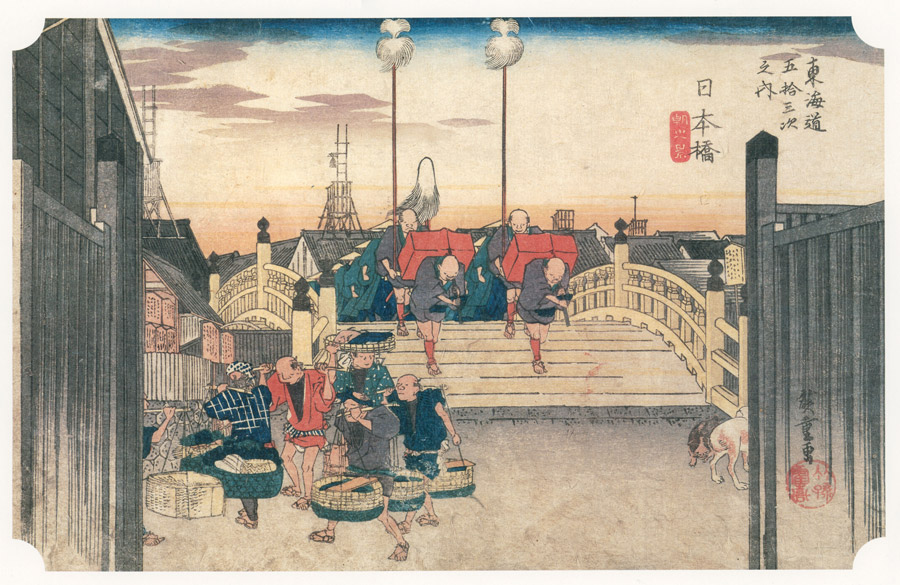In every country, there seems to be a type of travel video that’s become a genre of its own. You know the kind: someone decides to walk across the country, cycle from one coast to another, or visit every prefecture in a nation.
So, what’s the story behind this bridge? Why do people
keep coming back to it?
A Bridge With a 400-Year Head Start
“Nihonbashi” literally means “Japan Bridge”, and
the name says a lot. This is no ordinary bridge. It has been the symbolic (and
official) starting point of journeys since the early 1600s. During the
Edo period, it marked the beginning of the Tōkaidō, the historic road
connecting Edo (now Tokyo) to Kyoto. Back then, travelers—whether they were
merchants, pilgrims, or even samurai—would begin their long walk from this very
spot.
To get an idea of what that journey looked like, you might want to check out the ukiyo-e series The Fifty-Three Stations of the Tōkaidō by Utagawa Hiroshige, first published around 1833. It’s a set of woodblock prints that beautifully capture scenes along the route, starting right at Nihonbashi. His artwork gives us a glimpse of how the road once bustled with life and how important this bridge was in the national imagination.
Still the Starting Point—Even in the GPS Era
That old road is long gone, but its spirit lives on.
Today, modern infrastructure follows the same route. The Tōkaidō Shinkansen
(the famous bullet train line), and National Route 1, both trace the
path of the original Tōkaidō. And Route 1 doesn’t just vaguely follow the same
direction—it legally starts at Nihonbashi. That means, if you're
planning to cycle or drive all the way to Kyoto or even further to Osaka or
Fukuoka, this bridge is still the official starting line.
Maybe that’s why modern adventurers, vloggers, and
cyclists like to begin here. It’s a way to connect with Japan’s long tradition
of overland travel—and to add a bit of historical weight to their modern
journeys.
A Historic Bridge Hidden in Plain Sight
You might expect a bridge this important to be grand and
scenic—but the reality is a bit different. Nihonbashi today sits under a
massive elevated expressway, built in the lead-up to the 1964 Tokyo
Olympics. It’s a bit of a letdown for first-time visitors. The overhead highway
blocks the view of the sky and casts shadows over the stone bridge below. Even
in the 1960s, this placement was criticized for ruining the historic scenery.
But there's good news: the Tokyo government is now
working on a major redevelopment plan to move the expressway underground.
The goal is to restore the beauty of Nihonbashi and bring back a more open,
human-friendly atmosphere to the area.
Look a Little Closer
Even if the setting isn’t perfect, the bridge itself
is beautiful, especially when you take time to look at the details. The
current stone bridge was rebuilt in 1911, replacing earlier wooden
versions. It features elegant carvings, bronze lanterns, and even
mythical creatures like kirin (a dragon-like beast) decorating its
balustrades. At one end of the bridge, you’ll also find a plaque marking
Kilometer Zero for Japan’s national highway system.
Nearby, you can see Nihonbashi Mitsukoshi, Japan’s
oldest department store, and several buildings with classic Meiji and Taishō
architecture. So while you’re here, take a walk through the
neighborhood—there’s more history than you might expect.
Why Not Start Your Own Journey?
Even if you’re not planning to walk to Kyoto or cycle
across Japan, Nihonbashi is a great place to start your own little adventure.
Take a photo by the bridge. Stand on the same stones where travelers stood
hundreds of years ago. Imagine the footsteps of those who began their journeys
from this very spot—some chasing fortune, others seeking peace, and many just
hoping to get to the next town before nightfall.
In the end, it’s not just a bridge—it’s a place where
stories begin. Yours could be one of them.




Comments
Post a Comment